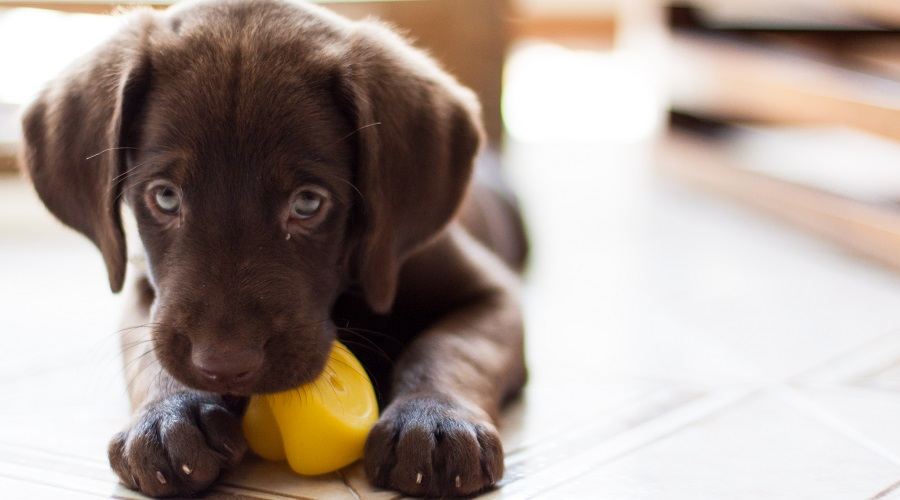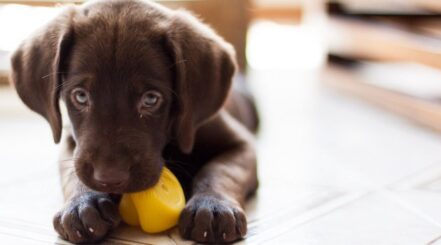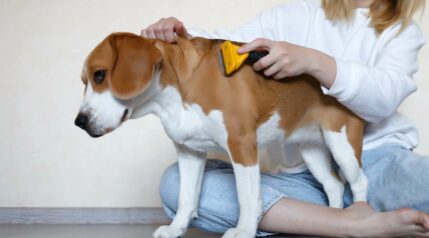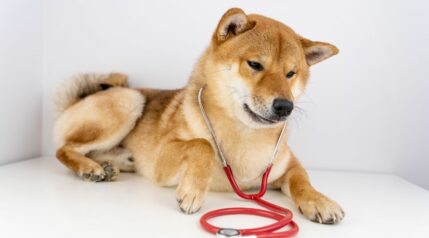Is your puppy constantly chewing on anything they can get their teeth around? Don’t worry – every puppy parent has been there. If your puppy is nibbling and chewing everything in your home, from the furniture to the skirting boards, it’s likely it’s just teething – a normal and natural process that every puppy goes through.
Teething can be an uncomfortable process for some puppies, but there are lots you can do to make it easier in their first year.
We’ve put together this guide to help you through this stage of your puppy’s development and to give you all the info you need to know about when your puppy will lose their teeth and what you can do to help them (and your furniture).
What Is Puppy Teething?
Excessive chewing is usually the first and most certain sign of teething. A lot of pet parents might easily mistake this for naughty or worrying behavior, but it’s a totally natural process that every puppy will go through in their development. Puppies are born without any teeth, and they develop their baby teeth (known as deciduous teeth) around 3 weeks after birth. The incisors (front teeth) appear first, and then the canines, followed by the molars and premolars last. In total, puppies have 28 deciduous teeth, which should all be present by around 6 weeks of age.
The teething process begins when those baby teeth start to fall out, and their permanent adult teeth come through, and this happens as your puppy’s jaw grows. This usually takes place when a puppy is around 3-4 months old. It’s this discomfort that leads to the chewing we all recognize as a sign of teething, as the gums can be quite sore. Chewing, especially on cold or hard items, is actually soothing for your puppy but can be quite destructive.
Puppy Teething Symptoms

The first sign of teething for most pups is chewing – chewing your furniture, the skirting boards, and door frames, and always wanting to have a toy in their mouth.
Some common and easy-to-spot symptoms of teething are:
- Excessive chewing and nibbling
- Small amounts of blood on toys or other things your puppy has chewed on
- Red, sore, or swollen gums
- Drooling
- Eating slowly
- Crying out or whining when chewing or eating
You might also find your dog’s baby teeth lying around, usually somewhere near their toys or an area they have been chewing on. Some pet parents like to keep their pup’s baby teeth as a keepsake. Sometimes, you might notice that your puppy has some crooked teeth or that the adult teeth come through while baby teeth are still in place. These are common problems that can be treated at the vet, so if you are concerned about your dog’s teeth, it’s always best to get them checked.
When Do Puppies Lose Their Teeth?
Puppies start to lose their teeth at around 3-4 months of age. These teeth are so tiny that most pet parents don’t even notice them falling out. Puppies actually swallow most of their baby teeth, as they tend to fall out while they are eating – don’t worry, this is completely harmless and normal. Sometimes, you might notice a small amount of blood around your pup’s mouth or slightly red/angry-looking gums. This is completely normal, too. As the larger baby teeth start to fall out, you might find these lying around the house, often near toys or items they have been chewing on.
By 6 months of age, your puppy should have lost all their baby teeth, and you should start to see their permanent adult teeth coming through. In total dogs have 42 permanent teeth – 12 incisors, 4 canines, 16 premolars, and 10 molars. These adult teeth have generally all come through by the time a dog is 9 months old. However, there is no strict schedule when it comes to puppy teething, and it can be different for individual dogs. The teething stage can continue until a dog is 9-12 months old.
Common Teething Problems

Second Set Of Teeth
Occasionally, the adult teeth come through before a baby tooth has fallen out, and you might notice that your puppy looks like they have 2 sets of teeth. This is a common problem with no obvious cause, but it can be quite uncomfortable for your dog. Usually, the retained baby teeth need to be removed at the vet under sedation or general anesthetic and are sometimes extracted at the same time as neutering.
Crooked And Broken Teeth
Crooked or broken teeth are also common and can be quite painful. Teeth often break when dogs are chewing on hard toys or surfaces or even eating bones. Often, these broken teeth need to be removed, but there are dental procedures available to mend broken teeth at some veterinary clinics. Certain breeds, such as Boxers, Bulldogs, Shih Tzu’s, and Pugs, are predisposed to developing an under or overbite (malocclusion) – if you notice anything unusual about your puppy’s teeth during the teething stage, it’s always best to get it checked by the vet as there are lots of simple treatment options available.
Excessive Chewing
Excessive chewing is usually the most problematic behavior when it comes to teething, and although it’s soothing for your puppy’s sore gums, it can be very destructive to your home and their toys. There are many things you can do to ease your pup’s discomfort and to help through this stage.
How To Help Your Teething Puppy
So, your puppy has started teething, and you’re probably wondering what you can do to help your fur baby feel more comfortable and get through this stage with ease. The good news is there are lots of simple and easy tips that can help you and your pup breeze through the teething stage.

Offer Your Puppy Lots Of Toys
Teething puppies are prone to excessively chewing, nibbling, or biting, and it’s much better for them to chew on suitable dog-friendly toys than potentially dangerous (or valuable) items in your home.
Make sure that your dog has a good selection of safe and suitable toys to help them ease their pain. There is a huge range of products on the market offering everything from soft toys for dogs with all their baby teeth to harder toys for those with their adult teeth coming through to toys that can be frozen to soothe sore gums.
The most important thing is that your pup’s toys are durable and don’t have any loose parts that could potentially come off and be swallowed. You also need to make sure that any toys you offer your pup are suitable for their size.
Give Them Something Cold To Chew
You can get lots of freezer-friendly toys from the pet store designed to help soothe teething puppy’s gums. But you can also do your own DIY version at home with a frozen carrot or ice cubes. Your puppy’s gums could become quite sore and inflamed when they are teething, so chewing on something cold provides great relief and helps your pup feel a lot more comfortable.
Puppy-Proof Your Home
When your puppy is teething and wanting to chew on everything it can get its teeth on, you need to be extra careful with items lying around your home that could be dangerous. Make sure any loose wires are secured and inaccessible, and keep any toxic plants well out of their reach, as well as shoes or items of clothing with loose parts. Bitter sprays can also be useful as they create a nasty taste that your pup hates and discourage them from chewing in that area.
Provide Plenty Of Stimulation
Distraction is often key when it comes to preventing chewing and giving your dog some relief from their discomfort. Keeping them occupied with enough exercise, as well as mental stimulation from games and interaction with family and other pets, is really important.
Training
Your puppy needs to know which items are off-limits when it comes to chewing. The only thing they should be chewing on is their toys. Positive reinforcement and high-quality reward is the most effective technique. You should never punish your dog for bad behavior. Simple commands and giving them their own toy followed by a reward is the best way to encourage good behaviors, but if you aren’t sure, get in touch with a registered trainer or behaviorist for support and advice.
Best Toys For Teething

Best Rubber
Puppy Kong

Best Tug Toy
Frisco Monkey

Best Plush
Multipet Lamb Chop
Note: Clicking the above links take you to Chewy.com, where you can get additional product information and customer reviews. If you make a purchase, we earn a commission at no additional cost to you.
Choosing the right toys for your teething puppy can be overwhelming, with so many different types on the market. When it comes to teething time, the best toys to offer your dog are those that are soft and flexible. Too hard a toy could cause the growing adult teeth to break or could be uncomfortable for your dog to chew on.
We recommend rope toys and rubber toys as these are comfortable to chew on. We also love teething toys that can be filled with water and frozen to soothe your pup’s gums and teething rings with slightly raised surfaces that massage sore gums. Plush, soft toys can also be really comforting for your puppy.
Final Thoughts
All puppies go through the teething phase, and while most sail through it with no problems, some pups experience some discomfort. There is no set schedule for puppy teething, but generally, puppies start losing their teeth at 3-4 months of age and have all their adult teeth by 9 months. You can help ease your pup’s discomfort and support them through this stage by offering plenty of suitable toys, cold things to chew on, and discouraging biting behavior. If you are concerned about your puppy’s teeth or notice anything unusual, always contact your vet for advice.





